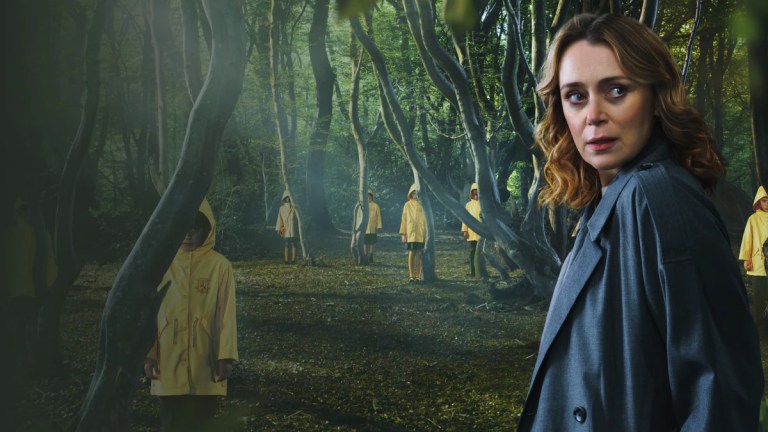The Midwich Cuckoos: Why John Wyndham’s ‘Monsters’ Are Perfect For Adaptation
Sky’s new series once again shows that Wyndham’s novels make the perfect templates onto which to project contemporary fears.

Warning: contains plot references to The Day of the Triffids, Chocky and The Midwich Cuckoos
Novelist John Wyndham’s genius lay in seeding menace among innocence. In The Day of the Triffids, the narrator drives through a bucolic country village but is unable to admire its delightful cottage gardens – partly because the world has ended, but also because the picture-postcard borders contain intruders: tall, swaying carnivorous plants with leathery green leaves and poison whips waiting to sting human flesh. Thus Wyndham turns that most pleasant and English of things, a flowerbed, into a deadly trap.
In Wyndham’s final novel Chocky, the threat arrives in the charmingly eccentric form of a child’s imaginary friend. In The Midwich Cuckoos, the unsettling element takes the shape of a cherubic, blonde-haired baby – or rather, 61 identical blonde babies foisted unexpectedly upon the women of Midwich after a village-wide blackout nine months earlier. In these stories, Wyndham’s monsters don’t stalk dark forests or do battle on alien planets, they live out in the bright English sunshine, among the foxgloves, in the nursery, and under crocheted blankets in the cradle.
Calling Wyndham’s creations ‘monsters’ isn’t quite right. His Triffids and Midwich Cuckoos are deadly and capable of monstrous acts, but they don’t act arbitrarily. As a rule, their violence must first be provoked; survival, not cruelty, is their aim. Interviewed in 1960 on the BBC’s Tonight, Wyndham took issue with interviewer Derek Hart’s assertion that his stories were about evil creatures from outer space. “I wouldn’t say they’re all evil. The Midwich Cuckoos look very evil in the film but they aren’t so evil in the original story.” Wyndham didn’t consider his novels scary. “Before the war when I was trying to write ghost stories I used to frighten myself pallid,” he told Hart. “These aren’t frightening, I think.”
Certainly Wyndham’s post-war novels aren’t designed as cheap spine-chillers. That much is clear from how little interest they appear to have in their so-called villains. In Triffids, there’s no scene taking readers into the lethal plants’ lair, or monologue from a head Triffid explaining its dastardly plan. They aren’t that kind of baddy. Their lethal existence drives elements of the plot, but it’s far from being the plot. The mysterious Children of The Midwich Cuckoos are more present and more central to their novel, and yet still remain at a distance. Wyndham only gives us dialogue between the Children and the people of Midwich, never taking us inside the Children’s hive mind or much behind the walls of the school to which they retreat from village life after a couple of years – without much protest from the women who gave birth to them.
Wyndham’s ‘monsters’ aren’t his real subject; his fascination appears to be with the destruction of the status quo, with how society and people react when metaphorical bombs are tossed into the heart of middle England. Doubtless, the non-metaphorical bombs of WWII – in which Wyndham served in France – cast a great shadow. His post-war novels all share a kind of shellshock, a disbelief that anything could dislodge the sense of safety once thought permanent. The Day of the Triffids’ narrator admits feeling bewildered that the mass blindness, lethal virus and killer plants have happened at home in England and not somewhere abroad, to the English and not to another nation. In The Midwich Cuckoos, the very dullness of the village was considered by narrator Richard as a kind of inoculation from events. “Something has happened here. Here, in Midwich,” he puzzles, “the place where nothing happens.” The novels both mourn for the end of safety and are exhilarated by it.
If Wyndham’s post-war context is key to his perspective on violent interruptions to everyday life, then screen and radio versions of his work in decades since have brought their own context to bear on his stories. His elusive antagonists – the Triffids, the Children – have proved usefully adaptable as a kind of blank page onto which contemporary fears can be projected. The 1950s’ concern about the threat posed to establishment values by the post-war generation found useful expression in Wyndham’s eerie, unknowable, mass-minded Children. Today? The generational divide is drawn along quite different lines.
Of more interest in 2022 than the threat of being superseded and overthrown by our children are the ways that motherhood can impinge on personhood. Reproductive rights, the social pressure to maintain an image of a perfect family life whatever the personal misgivings, manipulation into conforming to establishment gender roles, the taboo of resenting and fearing ones own child, or worse, wanting to abandon them or cause them harm…
Little of the above made it into Wyndham’s The Midwich Cuckoos, despite his progressive engagement with feminist thinking of his time. It’s all there though, and more, in Sky’s new seven-part TV adaptation, which gives the story a modern setting and makes fundamental changes to the source material that widen its storytelling possibilities. The Children in the Sky version aren’t all eerie blonde clones of one another, for instance, but share genetic characteristics with their mother. That choice is one of many that not only gives the adaptation a different look from say, 1960 film adaptation Village of the Damned, but also raises new questions about maternal attachment and just how human these ‘Cuckoos’ might be.
The Midwich Cuckoos starts on Sky Max on Thursday the 2nd of June.
